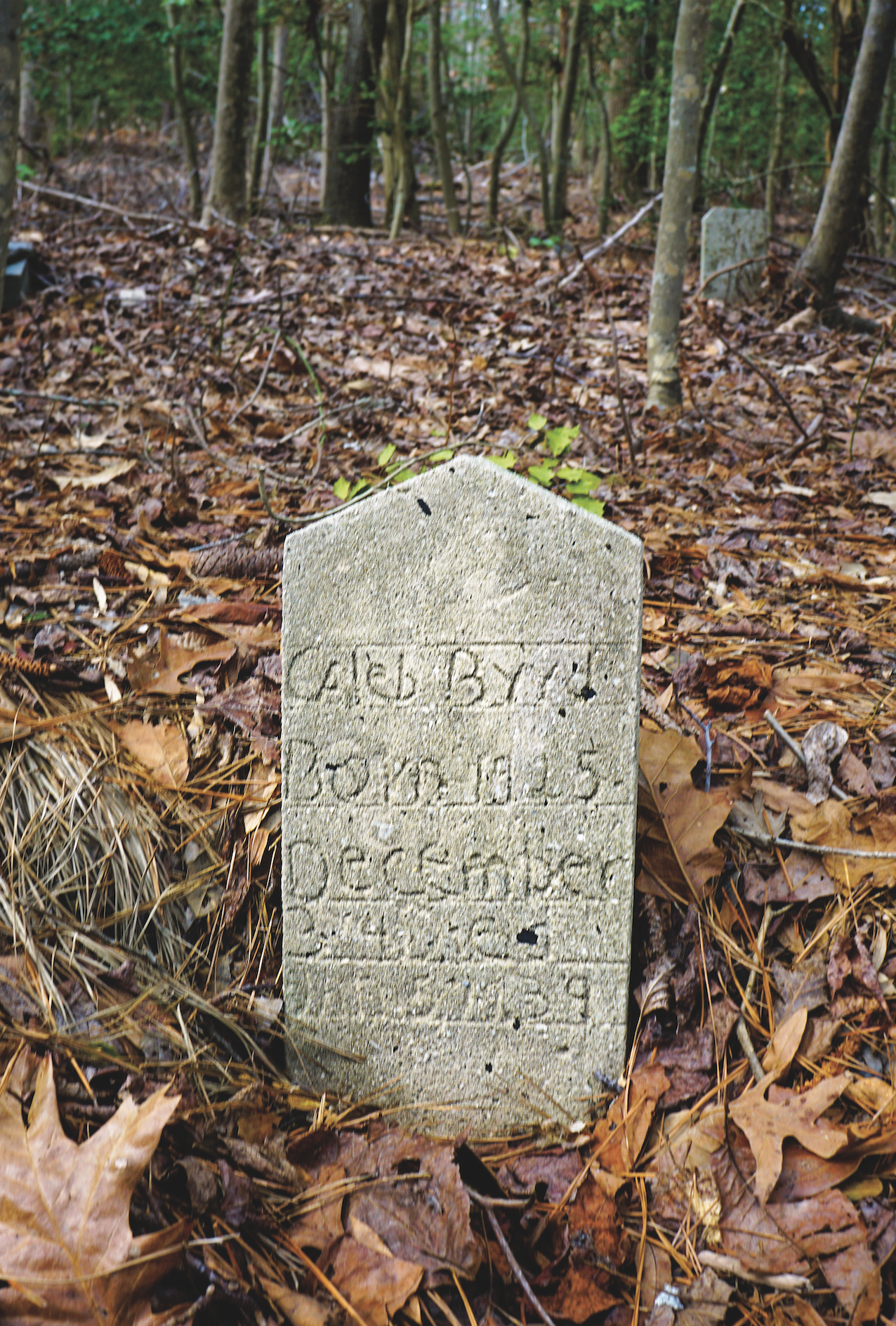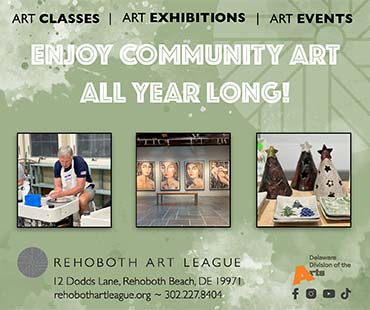
Some area cemeteries are barely recognizable after decades — or longer — of neglect. A few self-appointed caretakers are trying to change that, one headstone at a time.
By Bill Newcott
From the May 2021 issue

For the most part, the drivers tooling along Log Cabin Hill Road near Harbeson don’t notice the lady in the cemetery, but if they were to think about it, they’d realize she’s out there nearly every morning.
Weather permitting, Dinah Handy-Hall will be puttering around the tombstones of Coolspring Presbyterian Church, daintily applying cleansing solutions to the headstones of worn granite and brittle slate, lovingly placing flowers at some of the older gravesites. Sometimes her husband, Larry, will show up to help lift and reset a 200-pound monument that has tumbled due to wind or settling soil.
The rustic, rectangular church building was built in 1854, but it’s the third sanctuary to stand on this site. (See “A Church for the Ages” on page 42.) The cemetery dates back to the 1730s — and people who lived in the same century as William Shakespeare are among those buried there.
“I can stand at the gravesites of the McIlvaines or the Torberts,” Handy-Hall says, sounding as if she’s talking about the neighbors down the street, “and I know that 270 years ago their family stood at that very spot and said their farewells to their loved ones.
“Plus, the very same headstone has stood there all that time. With very minimal effort, I can extend the life of that stone by 20 years with just some water, a soft brush, and a biological cleaner.”
That cleaner is a product called D-2, and it’s the same stuff they use to keep the White House white.
“It’s quite expensive,” says Handy-Hall. “Sometimes there are stones that I have to clean as many as six times. But it works, and it doesn’t damage the stone.”
You would think this guardian of the cemetery must be a longtime member of Coolspring, or at least a descendant of its occupants. But no, Handy-Hall, a retired horticulturalist and landscape designer and recent transplant from Virginia, happened to be riding her bike along Log Cabin Hill Road about 14 months ago when she noticed the place and decided it could use some attention.
“I was heartbroken, because there was so much that needed repair,” she recalls. David Wall, clerk of the church board, was more than happy to let Handy-Hall — who is a member of multiple cemetery preservation groups — get to work.
“There are about 675 stones out there,” she says. “I would say I’ve cleaned, preserved, reset or mended a third of them.
“There’s lichen, algae, mold, rust — sometimes all of those things. Over time the stone can become sugary, in which case my motto is ‘Do no harm.’ If cleaning is going to do more harm than good, I leave it be.”
Sometimes the birth and death dates carved into stones are obscured — and church lore has it that passing Civil War soldiers mischievously altered some, changing “ones” to “fours” and “sevens.”
“But you can often tell the rough age of someone even if you can’t find the date,” says Handy-Hall. “If there’s a tree [engraved] with a limb cut short, that means they died young.”
The volunteer conservator can’t explain her fascination with cemeteries, but it appears she was born with it.
“When I was little, I told my mother, ‘When I buy a house, it’s going to be next to a cemetery because I’ll never have noisy neighbors.”
The dead are underfoot all over coastal Delaware — there are some 700 identified cemeteries in Sussex County alone, according to Find a Grave, a leading web database. For every lovingly tended church yard like Coolspring’s, there are, perhaps, dozens of small, irregularly shaped scatterings of tombstones sprouting like stone mushrooms from fields and yards, even erupting unexpectedly in dense woodlands.
Rebecca Scheck is leading me through a tight collection of trees on the outskirts of the Coastal Club development, off Beaver Dam Road near Lewes. Within sight of some handsome two-story homes, we find ourselves facing a headstone, remarkably preserved, considering our surroundings.
A small tree is growing directly in front of the stone, so you need to stand off to the side to get a good look at it. Elihu Sparrow lies under this leaf-strewn patch of woods, “At Rest” since 1928. Nearby, a rough-hewn stone, seemingly carved freehand, marks the grave of Caleb Byrd, just 14 when he died of appendicitis,
I later learn, in 1939. (See photograph on pages 48-49.)
“It makes me feel a little sad that they’re out here like this,” says Scheck, who moved here from Pennsylvania in 2018. “If you look around us, you can see these aren’t the only graves out here.”
Chillingly, she’s right. I cast my eyes on the forest floor around me and turn 360 degrees. All around us, like indentations on a lumpy bed of leaves, shallow elongated bowls are visible in all directions. Later I’ll do some cursory research online. This little patch of sacred ground is officially dubbed the Hevalow Cemetery, but also known as the Sparrow Cemetery. There are at least 37 people buried under our feet, African Americans whose birth dates reach all the way back to 1831.
The leaves and “winterfall” crunch beneath our feet as we head back out to the nearby street. We cross a wooden bridge, over a tributary of Goslee Creek. Then we’re on Coastal Club’s paved Eagle View trail, heading up an incline — toward a fenced-in, cleaned-up small cemetery in a wooded area just behind where new multi-family housing is being built.
“The hiking path used to run right through here,” Scheck says, indicating the northeast side of the burial ground. “Then they realized there were bodies under there, so they moved it over.”
It appears the builder has surrounded the burial site with the kind of fencing you’d use to enclose a swimming pool. The gate latch lifts easily, and we head inside.
This is the Lank Family Cemetery, the place where the longtime farmers of that name became one with the land they tilled for a century or so. Because we are almost directly across the creek from the African American Sparrow Cemetery, I can’t help but wonder what the relationship was between the two families.
At first glance, the Lank graveyard seems infinitely better cared-for than the Sparrow. But Scheck, who stops by periodically to tidy things up and straighten falling stones, points out a large animal burrow excavated into the sinking grave of “Mary, Wife of William Lank,” who died in 1887 (see photograph below).
“There are foxes here,” she says matter-of-factly. “Sometimes things get dug up. They once had some trouble with grave robbers. I found the heel of a shoe over there, by the fence, a week or so ago. And then, there’s this … ”
Scheck squats down and moves three red bricks from a small hole. Beneath them, pitted by the elements and a shade redder than the dead leaves surrounding it, lies a long, thick, intact bone.
“I think it’s human,” she says. “I think it’s a humerus bone, the one that goes from your shoulder to your elbow.”
We stare at the thing. I can’t help but wonder who among the people we’re 6 feet above is missing that bone — and how many more parts of them are scattered in the woods around us. The beep-beep-beep of a backing forklift floats across the narrow field separating us from the construction.
Scheck, a former art student who ended up working for the phone company her whole life, is philosophical.
“It’s just a reminder,” she says, carefully placing the bricks back on top of the bone. “Our body is just a suit of clothes to hold on to your soul.
“Or your innards, depending on how you want to look at it.”
One thing I discovered: Property developers like to talk about cemeteries the way restaurant chefs like to talk about E. coli. Curious about how they handle the discovery of burial grounds right where, for instance, the clubhouse is supposed to go, I contacted five major local companies. The result: I was ghosted like the AV nerd trying to score a prom date with the homecoming queen.
“That does not surprise me,” says Edward Otter, a Salisbury, Md.-based archaeologist/anthropologist who is the go-to guy when it comes to excavating cemeteries on the Delmarva Peninsula.
“What they do is they call me. They hire me to go out and delineate the cemetery, mark its boundaries so they won’t dig up any bodies when they start moving dirt.
“I’ve done dozens of cemeteries over the years where the developers know they’ve got one, but they don’t know how big it is. There’s always more graves than there are tombstones.
“Overall, developers are pretty good at checking things out.”
I am surprised — though I suppose I shouldn’t be — that he knows all about the Sparrow Cemetery.
“African American cemeteries are very often unmarked,” he says. “If you look closely there, you’ll find little pieces of building materials and conch shells that were used to mark graves.”
Otter is one of those lucky people who get to make a career doing precisely what they love to do: He says he’s been digging up bones ever since he was a kid. But a shocking number of folks are out there right now picking through gravesites for decidedly non-historical purposes, and it appears grave robbing is not a crime high on law enforcement’s priority list.
“Take the Lank Cemetery, for instance,” he says. “A couple of guys from Wilmington were actually grave robbing that, thinking they might come up with some Civil War relics. They got caught, but they only got something like a $50 fine. Another family just bulldozed a cemetery, and the cop who arrested them really wanted to prosecute them. But the state Attorney General’s Office just said, ‘Eh, we’re not interested.’”
I tell Otter about my startling experience with that big bone in the Lank Cemetery.
“More than likely, it’s a deer bone,” he says. “But if you send me a picture, I could tell for sure.”
Immediately after our phone chat, I e-mail Otter a photo I took of Scheck, the bricks, and the bone.
“That looks like a human humerus,” he responds almost immediately. “I know the Coastal Club people and will call them now.”
The oldest marked grave in this area is well-known and lovingly cared for: that of Margaret Huling (“In ye 76th yeare of her age 1707”) in the churchyard of St. Peter’s Episcopal Church in downtown Lewes. In general, though, much of the problem with knowing where all the bodies are buried appears to be our forebears’ relative comfort with the proximity of death. Whereas for the past century or so Americans have tended to segregate the dead into their own necropolises, prior to that our dearly departed seldom ventured more than a few yards from the front door.
“Cemeteries have a way of showing up when you least expect them to,” says Mike DiPaolo, former longtime executive director of the Lewes Historical Society. Now he’s the Delaware Community Foundation’s area vice president.
“Unlike, say, up in the Northeast, there are nearly no public cemeteries here; they’re mostly churchyard or family cemeteries. For one thing, the population size didn’t warrant public cemeteries — and also people had their own land.”
While at the historical society, DiPaolo oversaw the creation of a cemetery database, documenting every known burial ground in the area.
“Most people are respectful of the cemeteries on their property,” he says. “They realize the cemetery predates them, that they’re stewards of land that was occupied and tended to before their time.”
I am bouncing in a golf cart across a farm field outside Georgetown, headed in the direction of a small clump of trees a hundred yards or so away. My driver is Kate Bowski, a third-grade teacher at Milton Elementary School who owns a horse farm across the street.
“I was thinking of buying this land,” she explains, “and I learned that whoever bought it would be responsible for this little cemetery.”
Bowski didn’t buy the land. But she did adopt the cemetery.
“I blame COVID,” she says. “I was stuck in the house, bored out of my mind. One day I looked across the field and saw the sun just catching the gravestones. I said to myself, ‘I’ve got to get over there.’”
Bowski has always been a history and genealogy buff. She’s traced her own family, both sides, back to the 1700s. And now she saw the names etched on those nearly forgotten tombstones as another project. She copied the names that were still legible, reached out to local history buffs, and did her own online research.
We pull up to the edge of the gnarly grove. Bowski unfolds the printout of a family tree, based on her research. It traces the lineage of Noble and Betsy Conaway, both buried on this tract, both born in the early 1800s. Other names include the Wingates and the Manships and the Lawless (or possibly Wallace) clans.
At the grove’s center, marked by a telltale mound of fresh dirt, is the Lincoln Tunnel-like entrance to a fox hole. Instinctively, at this point, I begin watching my step lest I trample someone’s femur. As in every cemetery I’ve visited, there are large stones for adults and small ones for children — far too many of those. I can’t help but contemplate the inordinate amount of grief that accompanied the placing of those modest, tiny, often blank markers.
Some stones seem to be sandblasted by a century or so of prevailing winds; others are surprisingly well-preserved, possibly because they spent time lying flat against the ground before being re-erected.
Intriguingly, Bowski says, this cemetery is not yet included in the database of Find a Grave.
“I’m going to see to it that changes,” she says. “I’ve found some descendants who died as recently as 1977, so there must still be some family around, but I can’t find them. That would be really cool if I could.”
I catch her gazing at the family tree she’s created, and I sense there’s more to this project than mere boredom.
“I do feel an attachment to things that are beyond me,” she says. “I’ve always been fascinated with historical architecture, for instance. But this is a way to get up-close and personal.
“My family teases me. They ask me if I didn’t do what I do for a living, what kind of job would I like. I tell them I’d like to work in a morgue!”
We are bounding back across the field, and I turn to take one last look at this mysterious little cemetery.
If you’re driving around southern Delaware and see a grove like this one surrounded by a cleared area, it’s a pretty good bet there’s a cemetery in there someplace. You can close your eyes and imagine the pageant of the years: A long-ago family begins burying its dead in a field, or perhaps a clearing in the woods. Then they move on, or simply dwindle until there’s no one left to bury.
With passing years, the untilled land gives rise to weeds, then trees, until nature itself begins to reclaim it all. At last, those trees reach into the ground and sky, absorbing elements of the very people sheltered in their shade.
I do not find it an unpleasant thought.



